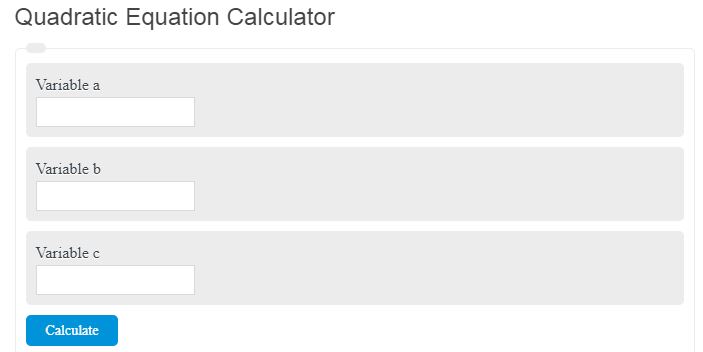Enter the variables, b, a, and c to calculate X in the quadratic formula. The result will display both values if more than one exists.
- Midpoint Calculator
- Linear Equation Calculator
- Unit Vector Calculator
- Multiplying Square Roots Calculator
Quadratic Formula
In algebra, the quadratic formula is the solution to the quadratic equation. The quadratic equation is:

Solving for X brings us to:

How to calculate the quadratic equation?
The solutions given by this equation are general referred to as the roots. In geometric terms, this is the location at which the points on the curve: y=ax^2+bx+c, cross the x-axis.
This equation is one of the most elementary formulas in algebra, but that does not mean it’s not important. It’s the basis for much more complicated math. This formula can be derived from “completing the square’.
In history, the earliest methods for solving this equation for explored as early as 2000 BC by the Egyptians and Babylonians, but was explored all over the world at different dates in history. Around 300 BC, a Greek mathematician, Euclid, used geometric methods to solve this equation.
Example Problem
We will now take a look at an example of how to solve the quadratic equation. This is also known as a quadratic equation solver or solving for the quadratic root.
First, from standard to vertex form, we need to grab the variables a, b, and c. Next, we enter those values into the formula from above. For this example, we will assume the values are 1,2, and 1 respectively.
Using the equation above yields the result of X= -1, 1.
FAQ
What is the quadratic formula used for?
The quadratic formula is used to find the roots of a quadratic equation, which are the values of the variable that satisfy the equation. It is a fundamental tool in algebra for solving equations of the second degree.
Can the quadratic formula give complex solutions?
Yes, the quadratic formula can yield complex solutions if the discriminant (the part of the formula under the square root) is negative. This indicates that the quadratic equation does not cross the x-axis and has no real solutions.
How do you determine the number of real solutions to a quadratic equation?
The number of real solutions can be determined by evaluating the discriminant (b²-4ac). If it is positive, there are two distinct real solutions. If it is zero, there is exactly one real solution (a double root). If it is negative, there are no real solutions, but two complex solutions.
Is the quadratic formula applicable to equations that are not in standard form?
For the quadratic formula to be directly applicable, the equation must be in the standard form ax² + bx + c = 0. If an equation is not in this form, it must first be rearranged into the standard form before applying the quadratic formula.
